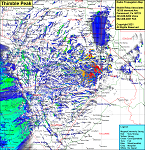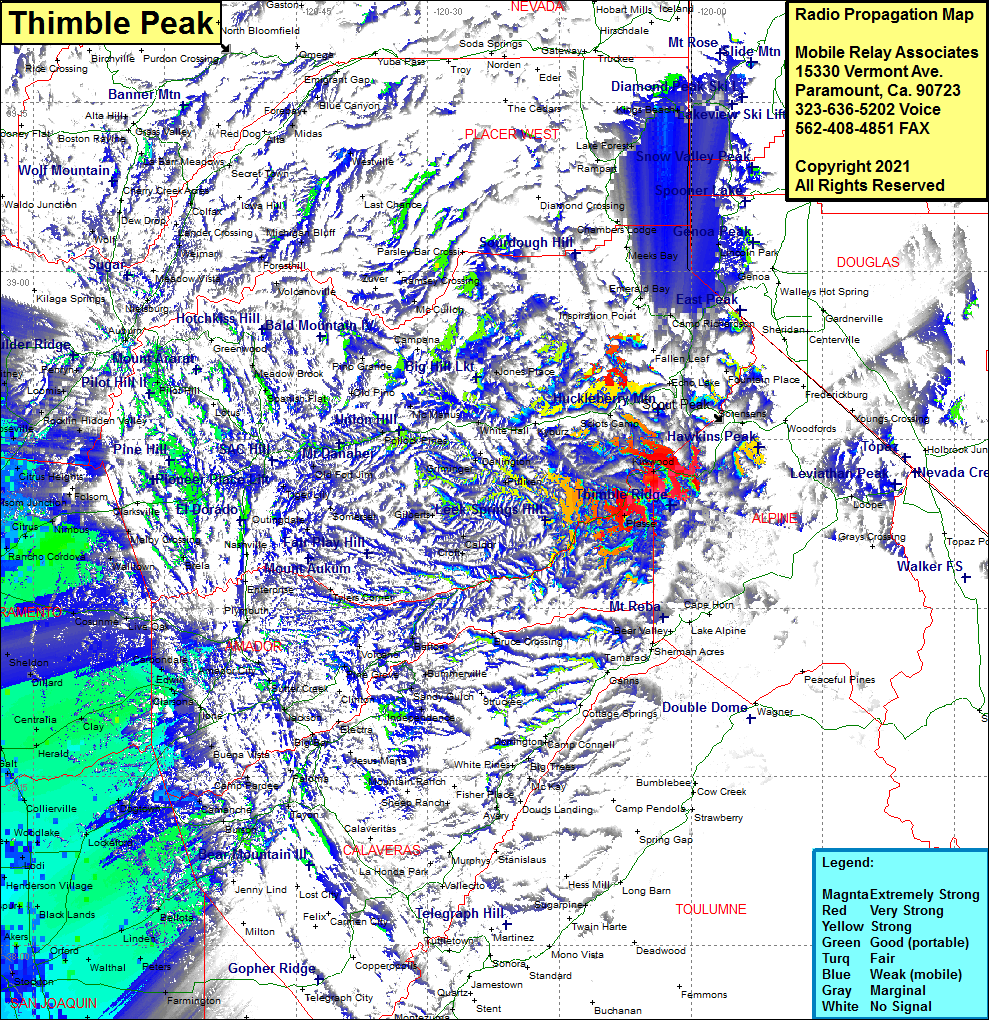Thimble Peak
| Site Name: | Thimble Peak |  Thimble Peak Coverage |
| Latitude: | 038 40 03.1N | 38.6675278 |
| Longitude: | 120 03 53.0W | -120.0647222 |
| Feet | Meters | |
| Ground Elevation: | 9489.0 | 2892.2 |
| HAAT: | 1,632.0 | 497.4 |
| City: | Kirkwood | |
| County: | Alpine | |
| State: | California |
This is not an MRA Owned Site. For space rental contact the site owner.
Do you own or manage this site? Click Here
Would you like to add a site to the Google Earth Map?? Click Here
Site Coverage: Coverage of Kirkwood, Plasse, Allen, Sorensens, Fountain Place, Mevers, Echo Lake, Fallen Leaf, Tahoe Valley, Kiva Beach, Idlewild, Lake Forest, Camilian Bay, Kings Beach, Lakeridge, Lincoln Park, Tahoe Village, Jones Place, Old For Jim, Bryants, Morrison, Pilliken, Voss, Bonetti, Golberts, Caldor, Croft, Omo Ranch, Tylers Corner, Aukum, Outingdale, Somerset, Placerville, Perks Corner, Shingle Springs, Kingsville, Dugan, Bullard, Cometa, Atlanta, Summer Home, Farmington, Manteca, Burnham, West Manteca, Lathrop, French Camp, Gillis, Holt, Stockton, Oxford, Walthal, Peters, Linden, Bellots, Black Lands, Henderson Village, Tomspur, Akers, Blackslough Landing, Trull, Werner, Bixler, Oakley, Antioch, ethe Island, Terminous, Rio Vista, Isleton, Toland Lancing, Dulton Montezuma, Molean, Lingos Landing, Pittsburg, Los Medanos, Port Chicago, Pierce, Teal, cygnus, Thomasson, Fairfield, Creed, Sucro, Five Points, Vale, Binghamton, Batavia, Dixon, Allendale, Vacaville, Batavia, Allendale, Hartley, Dixon, Yolano, Saxon, Arcae, Central, Greendale, Valdez, Sonoca, Burceville, Franklin, Vorden, Ryde, Isleton, Rio Vista, Woodbridge, Pollock, Arcade, Cordova, Riverview, Sacramento, Florin, Sheldon, WIlton, Walmort, Elk Grove, McConnel, Clay, Carbondale, Live Oak, Cosunme, Mather Field, Walltown,White Rock, Alder Creek, Folsom Jct, Foothill Farms, Citrus Heights, North Highlands, Robla, Walerga, rio Linda, Elverta, Sankey, Carlett, Roseville, Rocklin Hidden Valley, Loomis, Penryn, Whitney, Auburn, Kilega Springs, Sheridan, Wheatland, Wolf, Horstville, Arboga, Rio Oso, Trowbridge, East Nicolaus, WIlson, Abbott, Tudor, Oswald, Progress, Hinsdale, Cranmore, Millers Landing, Kirkville, Robbins, Marchant, Cunard, Yolo, Dufour, Zamora, Dunningan, Hershey, Herrington, Graino, Genevra, Arbuckle, Rumsey, Guinda, Knoxville, Tancred, Cadenasse, Esparto, Arroz, Citrona, El Rio Villa, Winters, Plainfield, Allendale, Hartley, Vacaville, Cannon, Batavia, Dixon, Binghamton, Vale, Five Points, Sucro, Creed, Fiarfield, Suisun City, Thomasson, Teal, Pierce, Cygnus, Bahia
